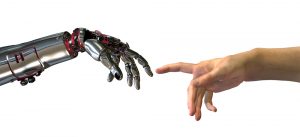 Algorithms, big data analytics and machine learning are just some of the technologies not only being used in business, but actually doing business. Increasingly, artificial intelligence (AI) is setting apart companies that move forward quickly. With computer programs that smooth out processes and make complex dealings simple, chatbots that alleviate customer service call queues and real-life robot helpers and companions, this is the age of AI.
Algorithms, big data analytics and machine learning are just some of the technologies not only being used in business, but actually doing business. Increasingly, artificial intelligence (AI) is setting apart companies that move forward quickly. With computer programs that smooth out processes and make complex dealings simple, chatbots that alleviate customer service call queues and real-life robot helpers and companions, this is the age of AI.
What does this have to do with stock market technology? Robotics has fallen in love with forex trading, it seems, and the results so far have made for a wonderful marriage.
How exactly is AI used in forex trading?
A forex trading robot is an automated computer program rather than a robot. In the same way that signals help a human trader, signals, moving averages and other indicators help a robot determine whether or not it should buy or sell. This is beneficial in the sense that a robot will execute a purely strategic decision based on the facts, unhindered by emotion and the other psychological factors that can cloud human judgment.
Forex trading robots are built using MetaTrader and employ the MQL scripting language, as well as machine learning. That means they can learn to copy and predict moves based on how you would normally trade. You can purchase a third-party forex trading robot, or you can use the computer input language to ensure the robot follows your human logic (minus the emotion). The advantage is that unlike you, a robot can execute thousands of trades per second. It is this same high-frequency trading that is often cited as the cause of market volatility, but with it also often comes far higher returns thanks to the tremendous scalability of high-frequency trading.
What is the human element of forex trading?
Veteran traders will tell you that 60% of a trading strategy is built on the focus and discipline it takes to control emotions and zone out the irrelevant, whether it is a false breakout or anything else.
This “zoning out” can be achieved by organizing the process of trading into left brain and right brain principles. The left brain is logical and holds the skills needed for successful trading. The emotions that can sabotage a trade are fear, greed, impatience, anxiety, etc. Similarly, being driven not by motives to make a profit but to avoid loss can lead to reckless, untimely moves. Success, on the other hand, can do the same if a trader develops an unfounded God complex.
As a trader, the fundamental forex advice you should heed is that you are never bigger than the market; you are never in control of the market. It has been hypothesized that the ideal state for a trader is somewhere between anxious and reckless. This is why forex robots have gained in popularity – they take this complex range of human emotions and triggers out of trading.
Undoubtedly, there is a forex future with robots playing a prominent part in it. Learning to program your own robot is not as complicated as it sounds, but you must remember that even a robot coded to the best standards is no guarantee of 100% profits or a mistake-free trading system. Yes, forex bots can break new trading frontiers, but you should use them as an aid rather than relying solely on them. Nevertheless, the future is decidedly AI. That should come as no surprise at a time when the search command “OK Google” is already second nature to tens of millions of ordinary people around the world.